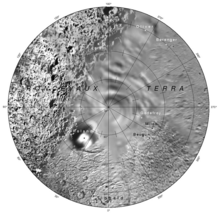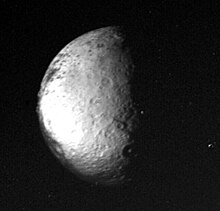



Roland is a 144 km (89-mile)-wide crater near the north pole of Iapetus, a moon of the planet Saturn.[2] It lies inside one of the bright areas on Iapetus called Roncevaux Terra. Images of Roland shows that it has a central peak.
It is named after Roland, the titular main character and protagonist of the Song of Roland, a medieval epic poem. All other surface features on Iapetus are named after characters of this poem.[3]
It is located at 73°18′N 25°12′W / 73.3°N 25.2°W / 73.3; -25.2.[4]
No high resolution image of Iapetus' north pole has been taken up to date. This makes it difficult to make a highly detailed map of Roland.
The first-ever probe to visit Saturn was Pioneer 11. Although it did not take any pictures of Iapetus at all. The next probe Voyager 1 visited Iapetus on November 12, 1980. However, it zipped by Iapetus along its equator and not its poles, making it difficult to see Roland from its very brief flyby.

The first probe to photograph Roland was Voyager 2 which passed by the north pole of Iapetus on August 22, 1981, during its flyby of Saturn.[5]
The latest mission to visit Saturn was the Cassini spacecraft which arrived at Saturn starting on July 1, 2004.[6] It provided the clearest and best images of Roland during its scheduled flyby on November 12, 2005.[7]
|
| |||||||
|---|---|---|---|---|---|---|---|
Listed in approximately increasing distance from Saturn | |||||||
| Ring moonlets |
| ||||||
| Ring shepherds |
| ||||||
| Other inner moons |
| ||||||
| Alkyonides |
| ||||||
| Large moons (with trojans) |
| ||||||
| Inuit group (12) |
| ||||||
| Gallic group (7) |
| ||||||
| Norse group (100) |
| ||||||
| Outlier prograde irregular moons |
| ||||||
| |||||||